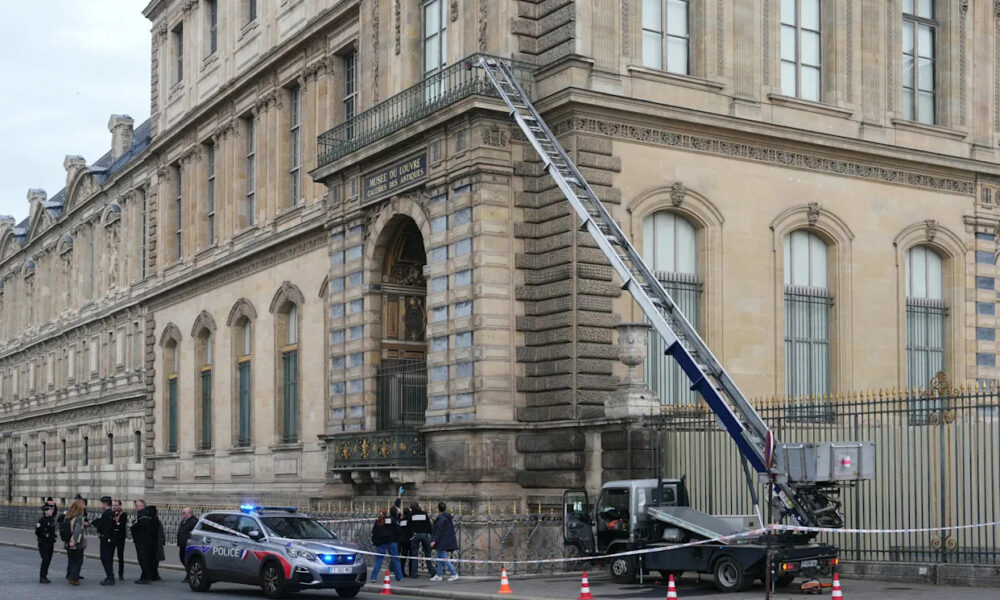A daring heist at the Louvre Museum in Paris has led to the theft of eight invaluable pieces of jewelry, marking the first major art theft from the institution since 1998. The robbery occurred on Sunday, with thieves disguised as museum staff executing the operation in a remarkably quick time frame, reportedly within just seven minutes.
The assailants accessed the museum using a truck-mounted basket lift to reach a window on the exterior of the building, breaching security shortly after the museum opened its doors for the day. In a calculated move, they smashed display cases in the Galerie d’Apollon and fled the scene on motorbikes. As of Monday, the Louvre remains closed while authorities investigate the crime.
According to France’s Ministry of Culture, the stolen items are described as “objects of inestimable heritage value.” Among them, a notable recovery was made near the scene: an ornate gold crown belonging to Empress Eugénie. The Ministry stated, “Thanks to the professionalism and swift action of the Louvre’s agents, the criminals were put to flight, leaving behind their equipment and one of the stolen objects, namely the crown of Empress Eugénie, the condition of which is currently under review.”
Art detective Arthur Brand emphasized the urgency of the situation, indicating that police have only one week to recover the remaining stolen jewels. He explained that the high-profile nature of the pieces means that the thieves might attempt to dismantle them for their materials. “If they catch the thieves, the stuff might still be there,” Brand said. “If it takes longer, the loot is probably gone and dismantled. It’s a race against time.”
The Stolen Pieces: A Glimpse into History
The theft includes several historically significant jewelry items, each with a rich background.
One of the key pieces is a diamond-and-pearl tiara and brooch, originally crafted for Empress Eugénie by jeweler Alexandre-Gabriel Lemonnier in 1882. The tiara features an impressive 212 pearls and 1,999 diamonds, alongside 992 rose-cut stones. Also taken was Eugénie’s large bodice bow, designed by jeweler François Kramer. This item, adorned with 2,438 diamonds and 196 rose-cut stones, originally served as the buckle for a diamond belt that was exhibited at the Universal Exhibition of 1855.
Another significant theft included a sapphire jewelry set, which features a tiara, necklace, and a single earring that has been worn by notable figures such as Queen Hortense and Queen Marie-Amélie. While the designer remains unknown, the necklace is adorned with eight sapphires and 631 diamonds, highlighting the exquisite craftsmanship of Parisian jewelry.
Additionally, an emerald necklace and earrings gifted by Napoleon to his second wife, Marie-Louise of Austria, in 1810, were taken. Crafted by jeweler François-Réginald Nitot, this set includes 32 emeralds and 1,138 diamonds and has been part of the Louvre collection since 2004.
The final stolen item is a diamond and gold brooch referred to as the “reliquary brooch,” created in 1855 by jeweler Paul-Alfred Bapst for Empress Eugénie. This intricate piece consists of a total of 94 diamonds, showcasing the exceptional artistry of the period.
The Impact of the Heist
The theft has not only raised concerns about the security of art institutions but also highlighted the cultural significance of the stolen items. Each piece carries historical weight, representing a connection to France’s regal past. The Louvre, renowned for its extensive art collection, faces not only the immediate challenge of recovering these pieces but also the long-term implications for its security measures.
As the investigation unfolds, the pressure mounts on law enforcement to recover the stolen jewelry before it is irretrievably lost. The art world holds its breath, recognizing that each passing day diminishes the chances of recovering these treasures.







